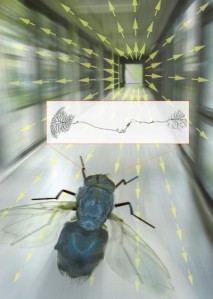'Flight simulator' for flies sheds light on visual processing

Despite its tiny limited brain, a blowfly performs difficult aerial maneuvers with speed and precision with the help of eyes that can perceive 100 images per second as discrete sense impressions, compared to about a maximum of 25 for human eyes.

Specific flight patterns are simulated by controlling optical "flux fields" presented to the fly. Credit: Max-Planck Institute for Neurobiology
How these flies can process optical stimuli fast enough to suddenly change direction, stand still in the air, and make precise, pinpoint landings, is a subject that has baffled a group of scientists at the Cognition for Technical Systems or CoTeSys in Munich, Germany. To find an answer, they've created a "flight simulator" to investigate what goes on in the brains of flies while they're flying.
By tethering and studying these insects as they experience virtual scenarios presented to them on a small wraparound screen, the researchers aim to put similar capabilities in human hands.
The simulator works by presenting diverse patterns, movements, and sensory stimuli to a blowfly held in place by a halter. The fly has implanted electrodes that register the reactions of its brain cells as it whizzes around virtual objects. The researchers observe and analyze the data using a fluorescent microscope. What they've found is that movements in space produce so-called "optical flux fields" that characterize specific kinds of motion for the fly. Here's the detail on how this works:
Moving pictures displayed here simulate flight for an immobilized fly. Credit: Max-Planck Institute for Neurobiology
"In forward motion, for example, objects rush past on the sides, and foreground objects appear to get bigger. Near and distant objects appear to move differently. The first step for the fly is to construct a model of these movements in its tiny brain. The speed and direction with which objects before the fly's eyes appear to move generate, moment by moment, a typical pattern of motion vectors, the flux field, which in a second step is assessed by the so-called "lobula plate," a higher level of the brain's vision center. In each hemisphere there are only 60 nerve cells responsible for this; each reacts with particular intensity when presented with the pattern appropriate to it. For the analysis of the optical flux fields, it's important that motion information from both eyes be brought together. This happens over a direct connection of specialized neurons called VS cells. In this way, the fly gets a precise fix on its position and movement."
Professor Alexander Borst, a neurobiologist at Max-Planck Institute for Neurobiology who is leading the study said, "Through our results, the network of VS cells in the fly's brain responsible for rotational movement is one of the best understood circuits in the nervous system.
The findings can potentially aid in a variety of robotic applications, such as in the development of small flying robots that can independently apprehend and learn from their surroundings, to the creation of intelligent machines that can interact with people directly, effectively, and safely.